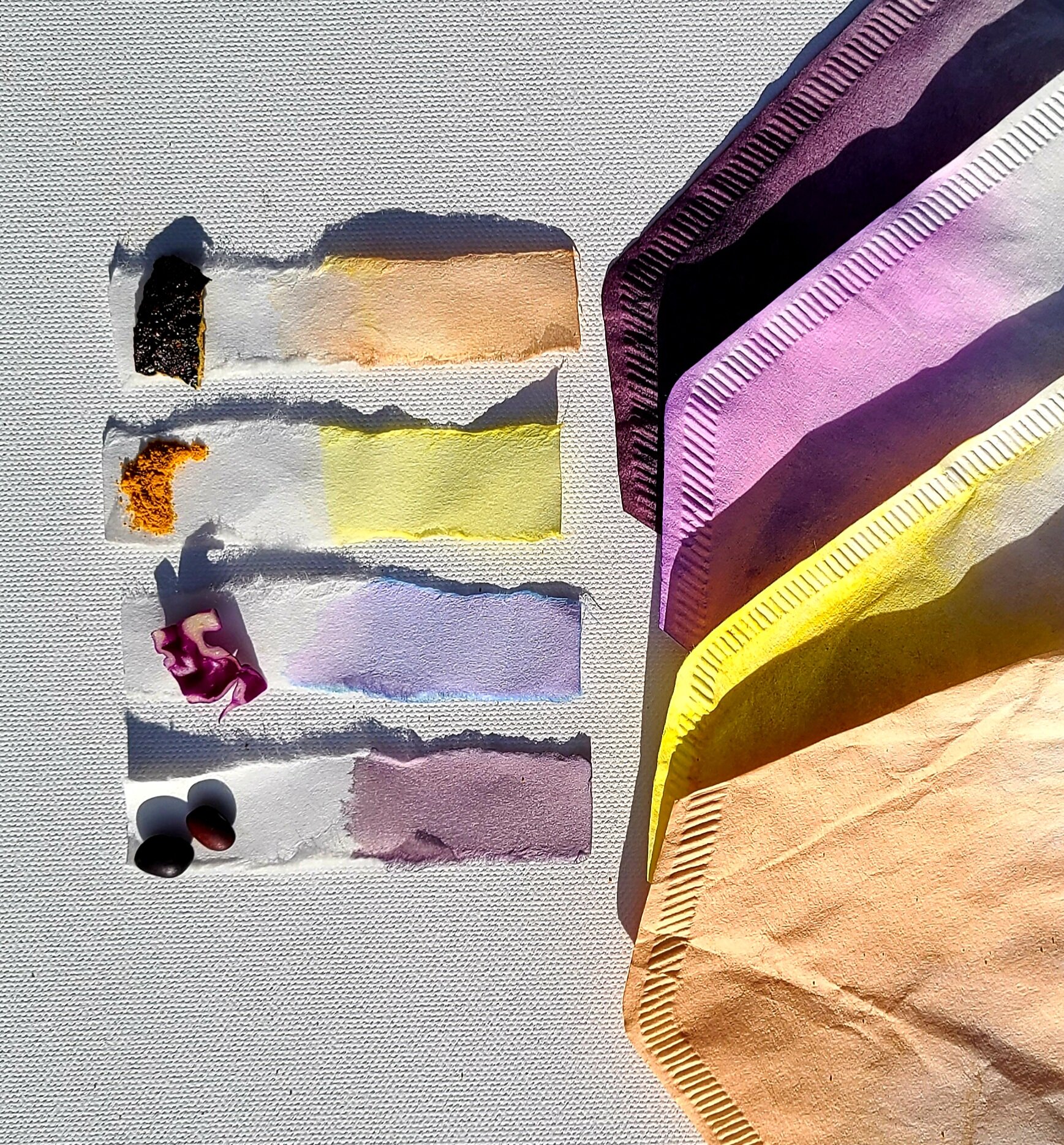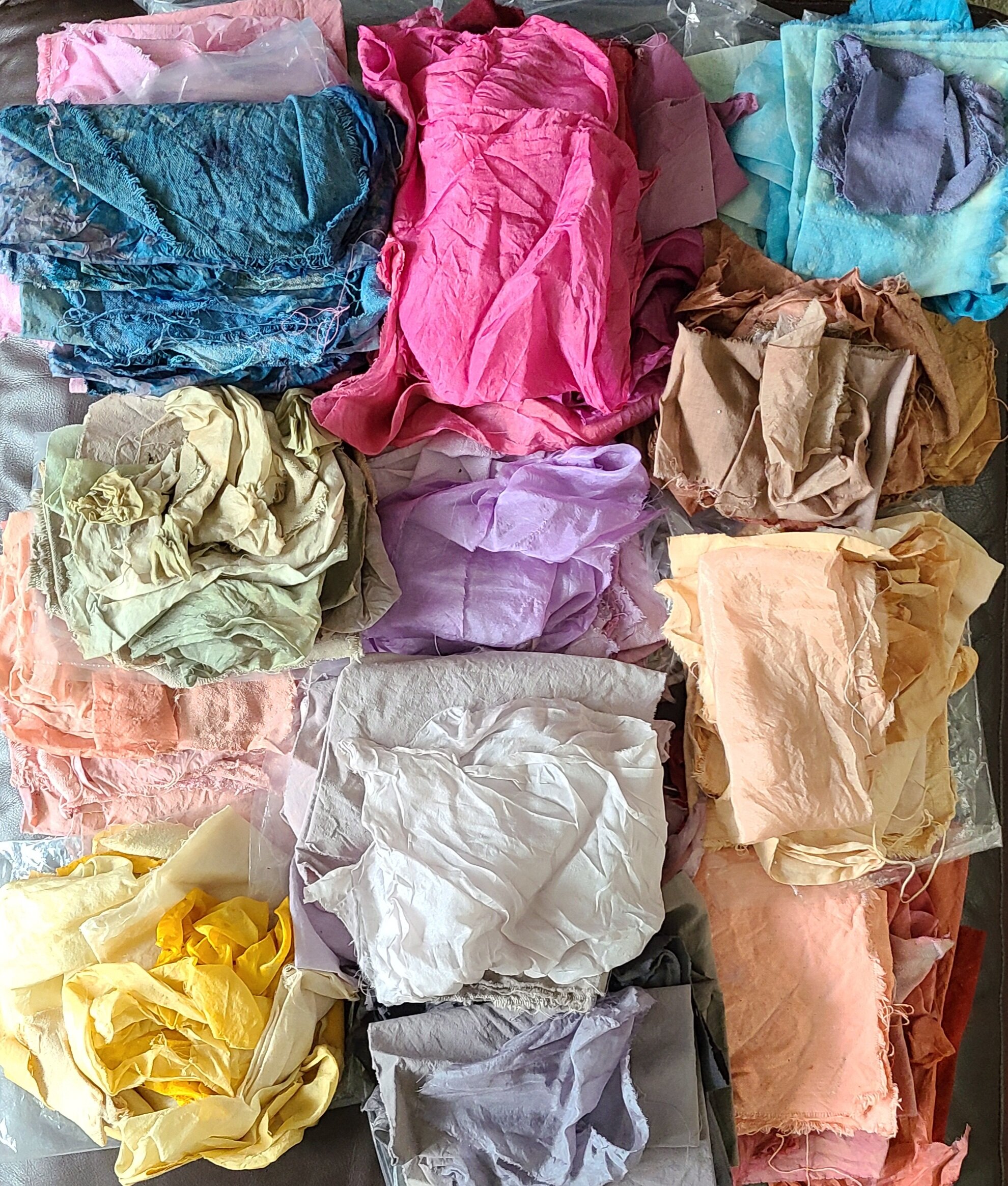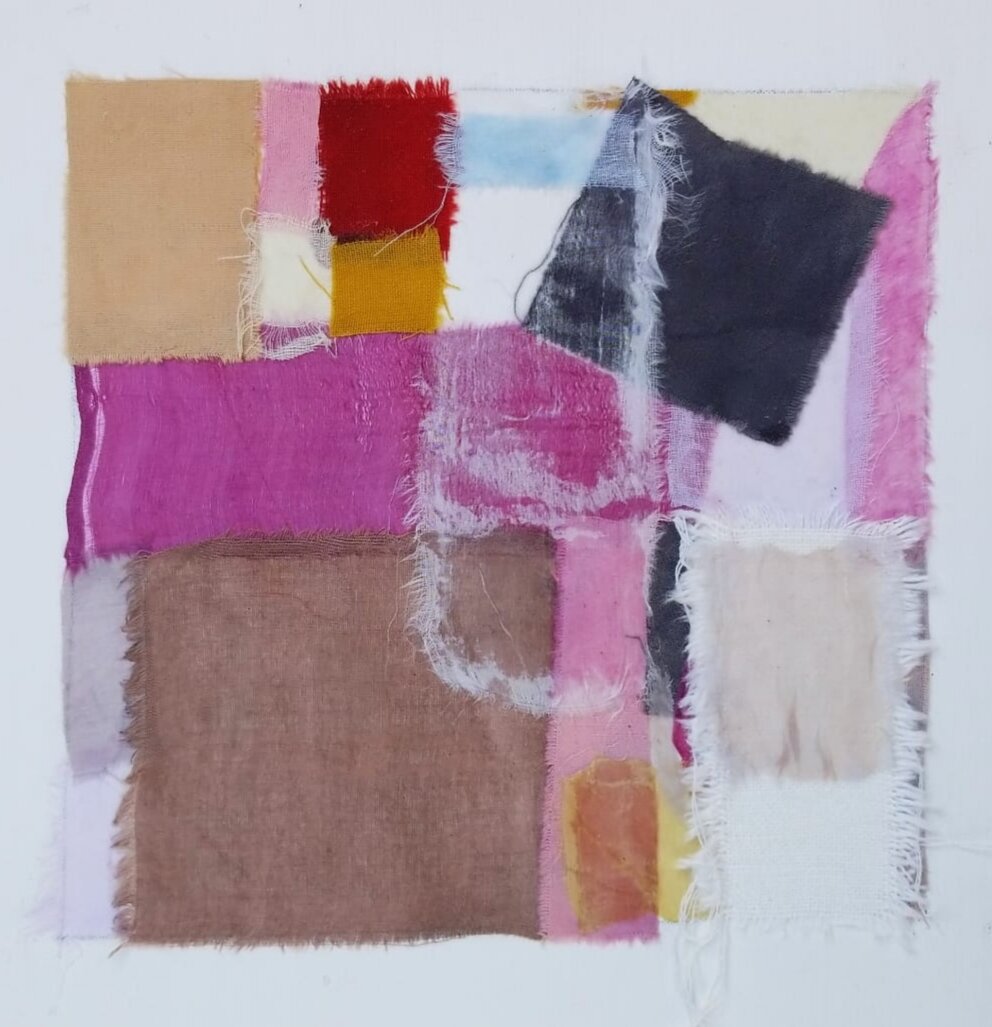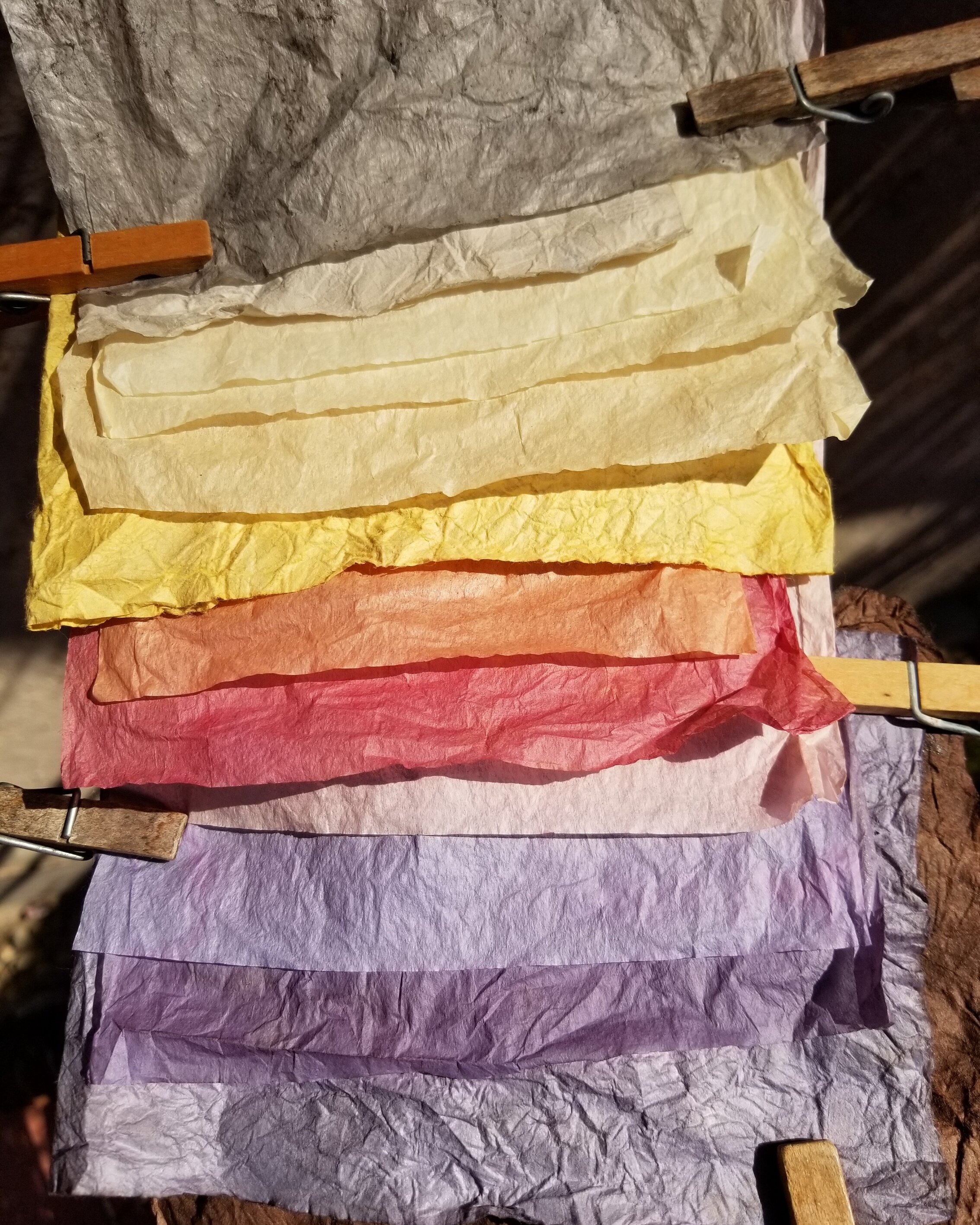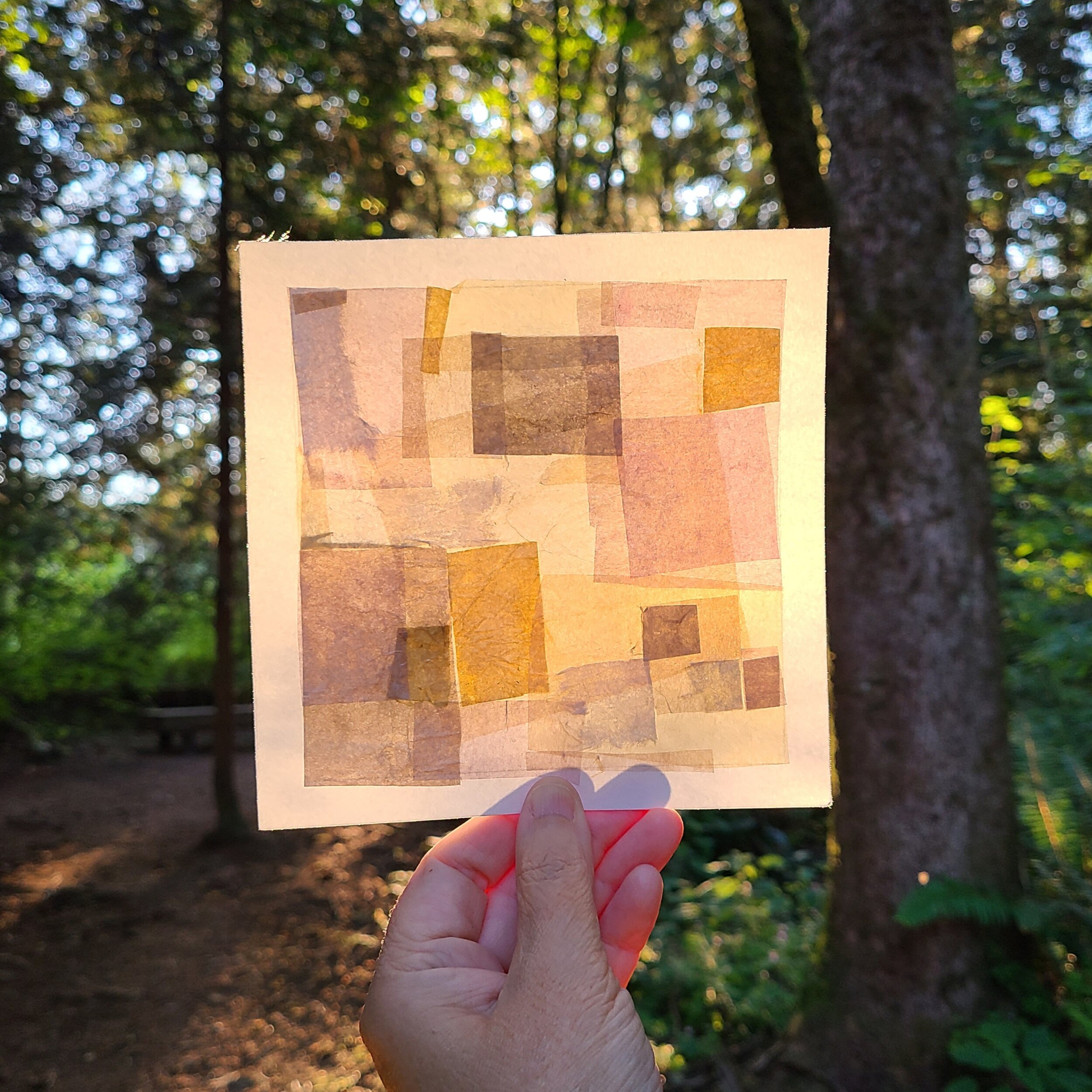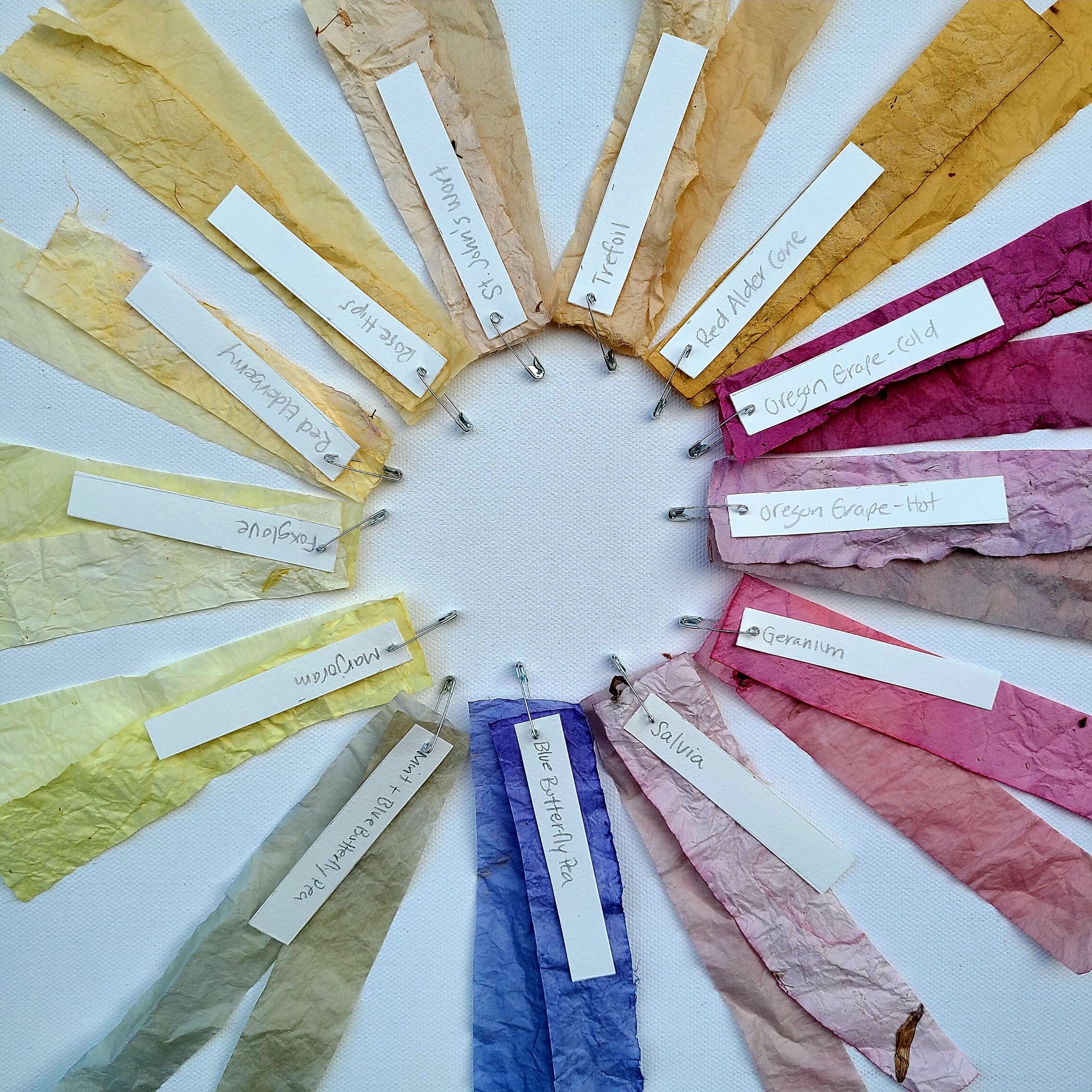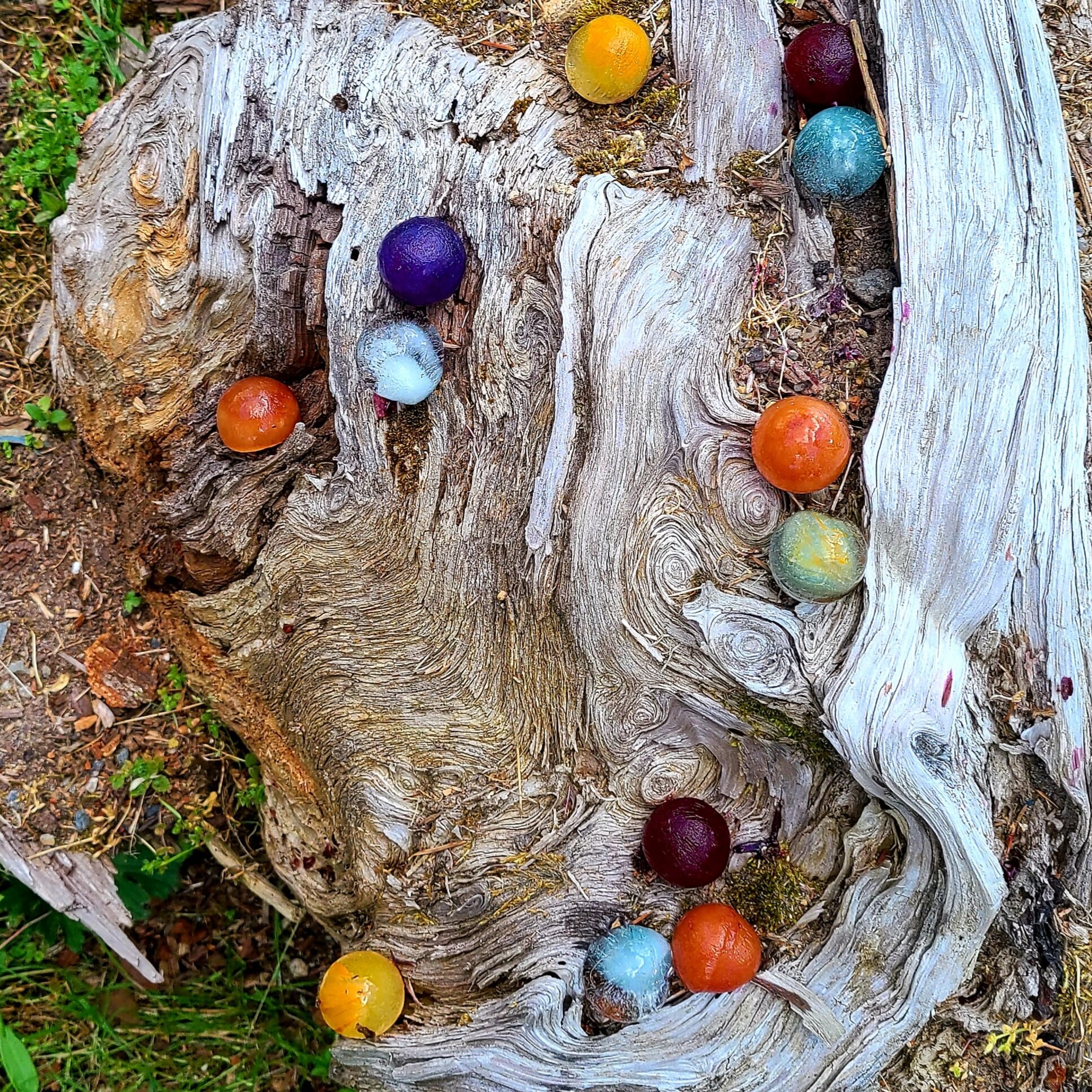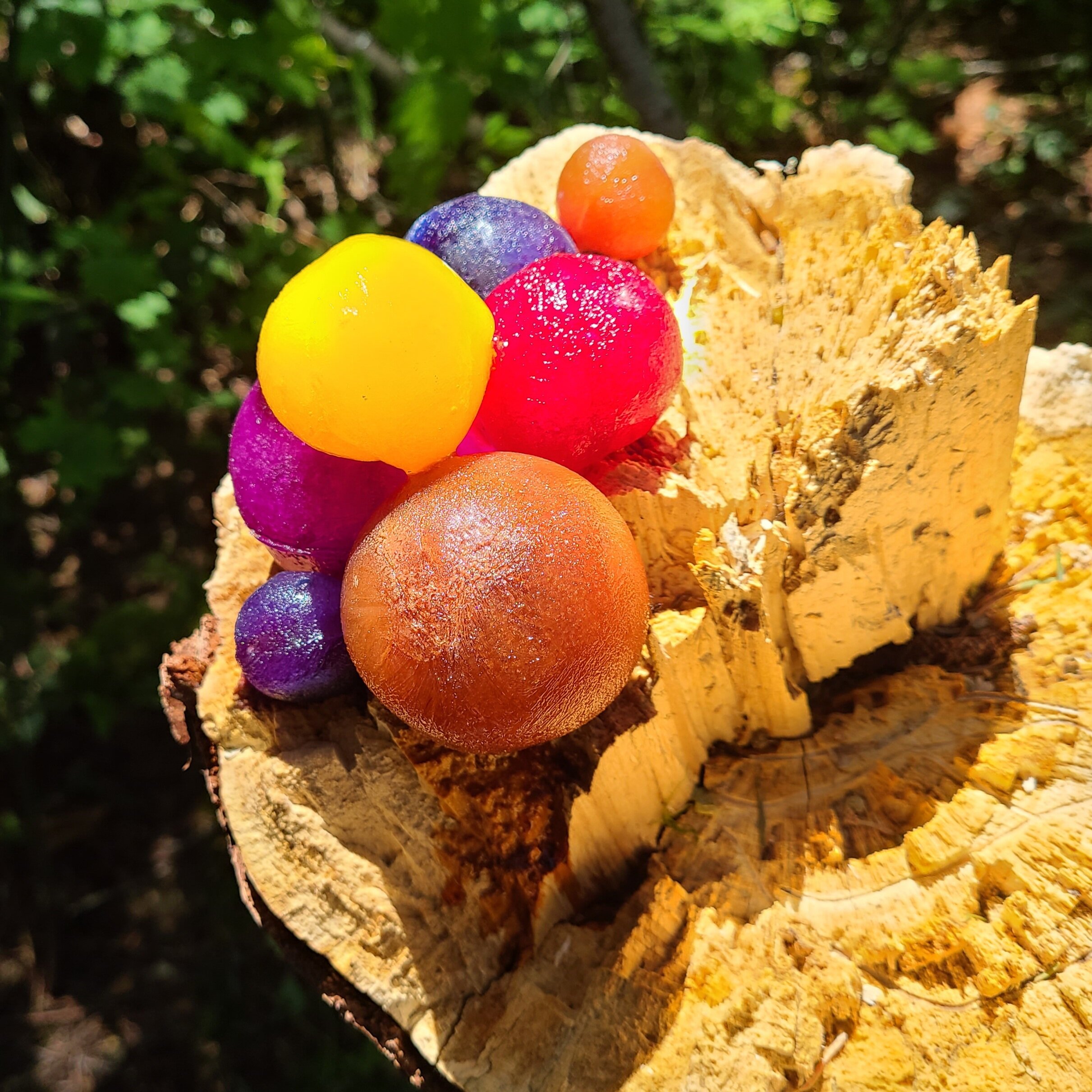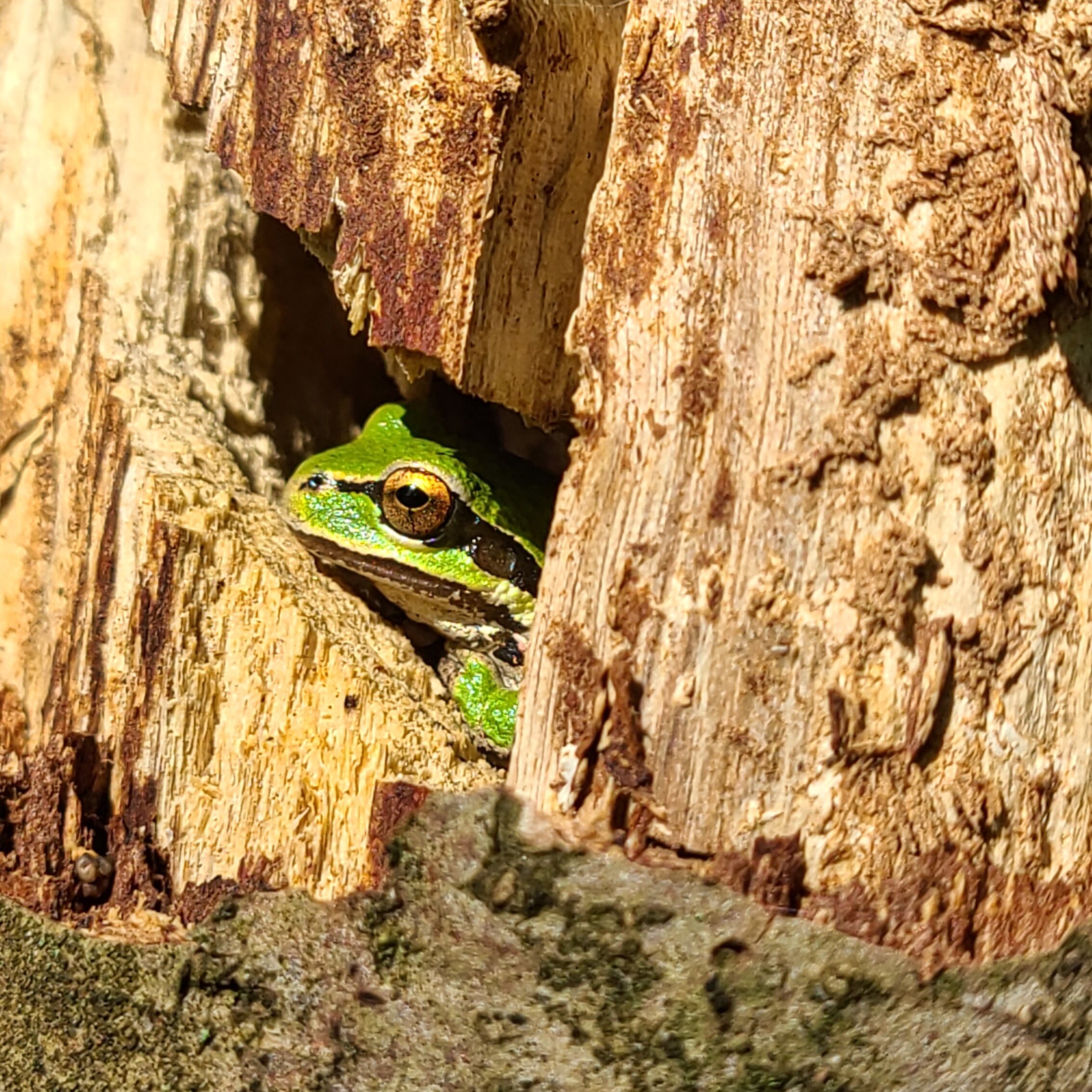Citrus peel is a natural way to create yellow dye for your textile and craft projects by using your kitchen waste. Using citrus to add zest to your cooking or for a quick snack? If so, start collecting the skins to throw in your dye pot instead of your trash bin! Any citrus will work: grapefruit, orange, mandarin, lemon, etc. This tutorial will show you how to brew dye from the peels, as well as the resulting color swatch samples (cotton & silk) with various mordants.
Yellow Onion Skin
Yellow onion skin is a natural way to create orange dye for your textile and craft projects by using your kitchen waste. Start collecting skins when you use onion in your cooking instead of throwing them away. If you don't cook with onions, no problem! The produce department in your local grocery store will happily give you their skins if you ask for them. This tutorial will show you how to brew dye from the skins, as well as the resulting color swatch samples (cotton) with various mordants.
Hibiscus
Hibiscus is a natural way to create red and pink dyes for your textile and craft projects. If you don't live in a tropical area where hibiscus grows naturally, no problem! You can use hibiscus tea or dried flowers (see links below) for a quick and easy organic color alternative. This tutorial will show you how to brew dyes from both flowers and tea, as well as the resulting color swatch samples (cotton) of both methods.
The Art of Craft
Small craft advisory
As an artist, I aspire to be crafty.
Forget the misguided, and tragically oppressive Western narrative of ‘high art’ as somehow ‘enlightened’ and more valuable than the exquisite beauty found across all creative expression labeled as ‘craft’.
If you can translate an idea from mind to hand, the material is immaterial – you are an artist - plain and simple.
My creative curiosity has led me down a crafty path or two, and I’m now enamored with one diversion so often associated with handiwork: natural dyeing.
Some of my kitchen favorites for natural dye: avocado, turmeric, red cabbage and black bean.
While I could fight against the notion that this diminishes the value of my art, why would I entertain such a silly thought?
Nope. I choose to celebrate, my artist friends, so let’s get crafting with natural color!
Color classics
Focusing on colors from nature in #The100DayProject has filled my fridge with an incredible rainbow of botanical dyes.
Dyes brewed from foraged plants and food scraps during #The100DayProject.
Every time I find a new plant to brew, I add to my collection. When I see a color missing, I go searching for a plant. It is a never-ending exploratory cycle.
10 dye plants foraged from Tambark Park and my garden waste to study local flora colors.
As I shared my project, and the art I created with these dyes, I could hear the buzz all around me as people became curious themselves. Certainly interested, and maybe even inspired, to learn about natural dyes.
I get this. I have a history of being intrigued myself. It’s how this passion for organic color grew and how I learned what I know so far. Ironically, it seems the more you know, the more you want to know.
Having had many of the same questions when I started my love affair with nature’s palette in 2017, I have been searching high and low for answers ever since.
When I learned from a Dutch artist that seaweed was a sustainable source of dye, I headed to Iceland to investigate.
And, because sharing is caring, I’m very excited to tell you a secret I’ve been keeping all to myself:
Starting in August 2020, I will be releasing short tutorial videos and mini-courses all about the incredible world of natural color. My intention is to build a place where you can easily find the basics to get you inspired to add color to your life naturally.
Soon to be released YouTube channel, Cookin’ Color, with short video tutorials on organic dyes, August 2020.
The topic is HUGE. There are so many options and different approaches to extracting color, plus a multitude of ways to use it.
For me, organic color has been an integral part of my installation practice, and more recently my mixed media work. But a beautiful aspect of natural color is that it is available to everyone, no matter where you consider yourself on the art/craft spectrum.
Bioplastics cooked and cured with natural dyes in my kitchen studio in June 2020.
And, the botanical dye in my fridge right now is a perfect example of the countless ways we can weave natural color into almost everything.
Nature’s bounty
Finding a way to create color in an ephemeral installation without hurting an environment is how I got hooked on natural dyes. But as my #100DaysOfNaturesColors meandered its way through botanical dyes and earth pigments, I could clearly see just how many different ways I have been exploring color from nature. Maybe one or more of these will strike a creative chord with you too!
TEXTILE
Probably the most obvious and popular use of natural dyes is to create sumptuous hues for fabric. With a growing interest of sustainability in fashion, botanical colors are popping up from head to toe. If you’ve got natural fibers in your closet (cotton, hemp, silk, wool), you can dye organically – the options are endless.
Textiles of wool, silk, cotton and bamboo hand-dyed in Oaxaca exclusively with organic matter.
My first on-line workshop will be on how to create an ombre-dyed scarf from foods in your kitchen, and this fall, I will be teaching a similar technique using earth pigments. Incorporating these rich colors into a wardrobe is a delicious way to get your art out of the house.
However, if knitting or weaving is more your speed, soaking yarn, string or ribbon in a batch of botanicals can create subtle sweetness. Just look at the wonder of this wool I dyed in Mexico.
Wood hand-dyed in organic matter including indigo, muicle, pericon and cochineal in Oaxaca, Mexico.
While I preferred to use this fiber for installation, imagine a hat, scarf, mittens or sweater with that special colorful touch?
But who says you have to wear hand-dyed textiles? My mom was an avid quilter which I’m certain has influenced my mixed media textile pieces and love of squares.
Naturally dyed textile piece, Blossom, created while on residency in Oaxaca, Mexico, March 2020.
How special it would have been to forage with my mom and organically dye fabric swatches for her to sew into her quilt creations. Keep that in mind for the quilters in your life.
PAPER
Textile’s extended fiber family is paper. The delicate translucency of paper has intrigued me for quite some time, both for sculptural and 2D applications. In Oaxaca, I first tested how wet strength fibers like mulberry and tissue would hold the colors I had brewed, and it worked like a charm.
First time hand-dyeing paper with plant matter in Oaxaca, Mexico, March 2020.
So, one chunk of 10 days during #The100DayProject, I focused on creating collage with these dyed papers. The variations of color, especially when layering, felt closely tied to the depth I love to create with overlays of silk in my textile pieces.
Hand-dyed paper collage backlit in Tambark Park, made exclusively from organic dyes foraged in Oaxaca, Mexico.
Feeling inspired, I foraged local ‘weeds’ in my beloved Tambark Park the last 10 days of the project and made a new rainbow stock of colorful paper from the PNW.
Paper samples of natural dyes brewed from foraged plants in my neighborhood. Only blue butterfly pea was from my kitchen!
What’s wonderful about paper is its versatility across several art disciplines, and a true staple in many craft projects. Why not make hand-dyed paper with plants foraged from your neighborhood the next time the scissors and glue need some exercise?
INK
Dyeing paper is one way to spread some of nature’s colors around, but making ink turns just about any organic matter into a medium for drawing and watercolor fun.
I simply poured the dyes I brewed from foraged plants in Iceland and Mexico on paper, but learning how to make ink specifically was yet another way to expand my natural color wheel during the last 100 days.
Testing inks made from avocado skin and red cabbage during #The100DayProject.
I even made blue ink with my cherished blue butterfly pea blossoms for the first time, one of the most elusive colors of nature.
Watch out - lake pigments might be just around the next corner!
KITCHEN KRAFT
While all of the above may result in time at a craft table, a stovetop is still a critical element in a studio of natural dyes. Therefore, it’s no surprise that crafts of the kitchen can also add a splash of organic color.
Much of my installation work was born in the kitchen - infused ice, mung bean and playdough have been some of my edible shining stars.
Mung bean string installation naturally dyed with kitchen scraps in Sayulita, Mexico, December 2018.
Brewing organic dyes as natural food coloring for baking, cooking and blended drinks is certainly a fun way to add color in the kitchen. At the very least, you can start with next year’s Easter eggs having that natural color vibe.
This year’s Easter Eggs were dyed au naturel in turmeric, red beet, red cabbage, avocado and blue butterfly pea.
Plus, the kitchen is the perfect place to start playing with natural dyes in general. So many fruits/veggies, spices and even food scraps can make wonderful colors with very simple recipes.
In case you missed it this spring, download a copy of my Cookin’ Color brew booklet with a few of my favorite kitchen dye recipes, or better yet, sign up here for my 5 Days of Dye short video tutorial series releasing soon in a kitchen near you!
HEADING
Go ahead – call me crafty. I don’t mind at all.
To be honest, I question why any negative association became attached to a word that honors the vision and skill it takes to create beauty with your hands. To be an accomplished craftsperson is a lofty goal for any artist, and certainly one I aim for in my daily practice.
So, let’s keep spreading the art of craft in the world today!
The Tambark Ten
Frozen
The itch to travel runs deep in my veins. Funny enough, I’m also strangely content to hole up in my home for long stretches of time. Perhaps the balance for me is having an alternating pulse of movement and stillness.
With travel at a standstill, walking has become my movement of choice this spring, and as luck would have it, a small forested land sits opposite my house – Tambark Park. Daily excursions into the lush greenery spurred inspiration that translated into a surprisingly abundant creative surge starring two of my art darlings: ice and installation.
Shot glass ice installations popping up all over the place!
Boy, have I missed you two!
100 steps
Heading into the fourth 10-day chapter in #The100DayProject, I committed to placing installation right outside my front door. Until now, I had connected my installation practice solely to the exploration of distant lands – a way for me to personally interact with a landscape that provided wonder and inspiration.
One of many ice installations inspired by the breathtaking beauty of Iceland, December 2017.
You don’t have to go far in the PNW to have this sensory experience of marvel. Slowing down and opening up to my local surroundings brought me simple joy, loads of chuckles and some pretty sweet photos.
Organic dyes of avocado, turmeric and red cabbage melting in all their glory.
Let’s meander through these 10 days together.
Spark
Full disclosure - I stole the idea to place installation in Tambark Park.
As the world shut down in March, a beautiful trend of leaving small gifts of love and hope emerged. Walking the trails, I started noticing flowering plants that were not indigenous to the undergrowth.
Did forest elves plant these colorful treats amongst the cedars?
It took the brightly colored blooms at the base of several looming evergreens to notice a pattern: Someone was planting these in the darkest corners of the forest to offer light.
Another sweet offering scattered across the property were colorfully painted rocks. Spying the hidden stones became a visual treasure hunt I looked forward to playing every day.
Some of the painted treasures even had messages of hope.
These acts of kindness poked at my creativity, and so bloomed 10 days of installation.
Icy roads
Colors from nature first appeared in my art as a non-toxic way to tint the ice pieces I placed in Iceland in 2017 – the launching point for my installation practice.
Winter sunset through blue butterfly pea and red cabbage in the Westfjords of Iceland, December 2017.
Frozen climates eventually graduated to balmy locations to push the limits of ice as an ephemeral medium.
From tiny rental refrigerators to mobile coolers meant for chilling wine and travel snacks, I froze all kinds of shapes and sizes of water infused with plant-based organic dyes I brewed. I took some crazy pride in the lengths I went to transport my frozen works of art to their installation destination.
The ice cooler is a must-have on installation road trips, Maui June 2018.
Ice was an obvious choice for Tambark Park to stay true to my project of #100DaysOfNaturalColor. And to be honest, I never had it so easy! Using my full-sized freezer, packing a thermal lunch bag and walking no more than 10 minutes to place installation was an absolute dream.
The beauty of ombre dyes frozen in a full size freezer is pure magic.
Note to self: it doesn’t always have to be so difficult!
Secret garden
Tambark Park has a network of trails that meander through a mixed woodland. The search for more pristine locations, however, had me traipsing off the beaten path where I found some amazing nooks and crannies in the greenery.
Ice stack placed where few have ventured except for fallen trees.
I may have been only 20 feet from the footpath I walked every day, but it transported me back to the days of my childhood where we spent muggy summer days hunting for hidden places in the brush to build forts and play hide-n-seek.
Bumping into fellow hikers in Tambark Park while reemerging from the secret spaces always garnered a curious look and sometimes even a smile.
The green light
Blazing my way through the thicket meant I stumbled into some of the PNW iconic vegetation: erupting ferns, fuzzy tufts of moss, horsetail reed and skunk cabbage. Such variations of green allowed for creative play that produced a visual tension with the vivid colors of the frozen botanical dyes.
A colorful shoot of ice in the midst of fern fronds.
The woody stumps of fallen trees provided sumptuous textures in a wonderfully neutral palette that also allowed the ice to shine.
Ice marbles wedged into weathered wood.
Possibly the second most exciting discovery was bumping into stinging nettles. Yes, they left their painful mark on my hand, but without this accidental collision, I would not have been able to identify this weedy herb.
The stinging nettle that bit me during installation will be a welcome addition to my dye pot.
Soon I will head back to collect the leaves because they make the most incredible gray-green dye, a color not easy to find in nature ironically.
Creature comfort
And what would the flora be without the fauna? Hiding among all of this incredible foliage, I was treated to chance encounters with all kinds of animals:
Rabbits flourish here and spring is the time of baby bunnies.
One lone squirrel would rustle in the trees in the same spot almost every day
A bat swooshed just above my head on a twilight installation.
Even a snake slithered its way across my path!
But, the ultimate treat, and yes, THE MOST exciting discovery was a tiny friend who joined me on the very first installation.
The first ice installation in Tambark Park had an unexpected spectator (see below photo).
Thanks to patiently waiting for the streams of sunlight to hit just the right spot, I was lucky enough to catch a glimpse, and a photo, of this sweet tree frog.
The tree frog who sat quietly for more than an hour while I placed ice and returned to its melted remains.
She didn’t dash away, and even when I returned an hour later to check on the ice melt, she was still cozy in her hole, taking in the afternoon rays.
Ice flow
Where there are frogs, there is water, and Tambark Park has a lowland marshy vibe trickling everywhere. Many a day was spent mucking through spongey ground to install, but I also examined how a stream’s gentle current would dance with my ice pieces.
Mother’s Day ice installation in honor of my mom, Maia, who passed away May 31, 2019.
I’ve played with kinetic energy in my installation work, and certainly the simple act of melting is an inherent trait of mobility in ice.
However, running water provided many more layers of movement to explore: Releasing, floating, bobbing, flowing, dissolving, and ultimately, disappearing.
Frozen floats of organic dyes in Tambark Creek gone within minutes of placing this installation.
Movement, in fact, may be implicit in the ephemeral – an idea I am just now realizing.
Micro-living
Ten tiny days of micro-travel has had a macro-impact on a deeper understanding of my creative practice. Slowing down to open the senses to my immediate surroundings has brought wide open space for reflection. Yet again, I’m reminded that movement can be a collective effort of small steps, as long as I actively nurture its momentum.
